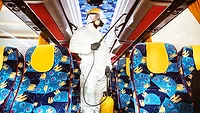The Intentional Restorer
Innovation will be Only Post-Pandemic Path Forward
There’s a lot of talk about remote work as companies test their ability to adapt to efforts to flatten the curve while keeping critical operations online. Andrew McCabe started in the property restoration industry in 1999, rose through the ranks and decided to start his own company thirteen years later. In 2012, freelancing as a remote Xactimate estimator wasn’t as common as it is now, but the entrepreneurial spirit is difficult to tame.
Our goal for this ongoing segment, Three Questions with A Pro, is to help gather pieces of the COVID-19 puzzle and share those with our peers in the restoration industry. Through The Intentional Restorer, I have been reaching out to a broad range of professionals within the various relevant fields to learn from their areas of specialty so that we can continue to work together to form common sense solutions. Please view the accompanying video of my interview with Andrew McCabe of Claims Delegates to hear all that Andrew has to share on these topics.
Resiliency, innovation and remote work are going to be more important than ever
A topic Mr. McCabe and I have discussed previously his book, The 24 Hour Tech. Andrew walks a company through the process of training a technician on what key data is needed for an estimator to be able to properly translate the story of a loss into an Xactimate estimate. He has a great saying, “Thickest file wins,” which speaks to the fact that as restorers we are paid for what we document and can defend.
We discussed how the Matterport system enables a contractor to elevate their site diagrams, expedite estimating and facilitate a more detailed capture of loss details. I was surprised to discover that the tool is much less expensive than I thought. Andrew also dispels the misnomer that the 3D data capturing platform is only for high end or commercial losses. Within property restoration, there is a constant need to set oneself apart through smart innovation that allows your team to expedite your process as well as expand the depth of your documentation.
Some benefits of 3D scanning tools:
- Andrew estimates that a 1,500 SF house can be scanned in about an hour.
- The 3D scan can be shared with all stakeholders to allow detailed reviews of the loss site. A whole structure scan eliminates concerns about missing a measurement or not having a key picture needed of the damaged area.
- Once a 3D scan has been made, the contractor has this resource to refer to for claims reviews, litigation or a loss recurrence at the same property.
- Another key consideration according to Mr. McCabe, if you are taken to court and you have to defend your workmanship, using traditional documentation, against a consultant that has utilized 3D scanning, you may find yourself in an uphill battle.
Andrew’s observations as coronavirus raises new questions about what the future holds
Those restoration companies who have been resistant to change, or behind the curve, will find that this novel coronavirus situation proves the need for innovation. Businesses are considering how they will respond to the outbreak of SARS-CoV-2. The expediency of 3D scanning systems has created opportunities for restoration companies with this technology to assist carriers and adjusters with remote loss inspection.
Thank you for reading, watching and listening to this content. The Intentional Restorer’s segment Three Questions with a Pro, brought to you in collaboration with Restoration and Remediation (R&R) Magazine and The DYOJO. Our goal is to connect, collaborate and conquer with our friends and peers in the property restoration community. You can also listen to this interview, with additional exclusive content via The DYOJO Podcast which is available on the Anchor, Spotify, Apple and Google podcasting platforms.
Looking for a reprint of this article?
From high-res PDFs to custom plaques, order your copy today!






